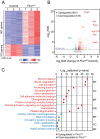Filamin C is Essential for mammalian myocardial integrity
- PMID: 36706168
- PMCID: PMC9907827
- DOI: 10.1371/journal.pgen.1010630
Filamin C is Essential for mammalian myocardial integrity
Abstract
FLNC, encoding filamin C, is one of the most mutated genes in dilated and hypertrophic cardiomyopathy. However, the precise role of filamin C in mammalian heart remains unclear. In this study, we demonstrated Flnc global (FlncgKO) and cardiomyocyte-specific knockout (FlnccKO) mice died in utero from severely ruptured ventricular myocardium, indicating filamin C is required to maintain the structural integrity of myocardium in the mammalian heart. Contrary to the common belief that filamin C acts as an integrin inactivator, we observed attenuated activation of β1 integrin specifically in the myocardium of FlncgKO mice. Although deleting β1 integrin from cardiomyocytes did not recapitulate the heart rupture phenotype in Flnc knockout mice, deleting both β1 integrin and filamin C from cardiomyocytes resulted in much more severe heart ruptures than deleting filamin C alone. Our results demonstrated that filamin C works in concert with β1 integrin to maintain the structural integrity of myocardium during mammalian heart development.
Copyright: © 2023 Wu et al. This is an open access article distributed under the terms of the Creative Commons Attribution License, which permits unrestricted use, distribution, and reproduction in any medium, provided the original author and source are credited.
Conflict of interest statement
I have read the journal’s policy and the authors of this manuscript have the following competing interests: JC consults for Lexeo Therapeutic.
Figures





Similar articles
-
Interaction of Filamin C With Actin Is Essential for Cardiac Development and Function.Circ Res. 2023 Aug 18;133(5):400-411. doi: 10.1161/CIRCRESAHA.123.322750. Epub 2023 Jul 26. Circ Res. 2023. PMID: 37492967 Free PMC article.
-
ROD2 domain filamin C missense mutations exhibit a distinctive cardiac phenotype with restrictive/hypertrophic cardiomyopathy and saw-tooth myocardium.Rev Esp Cardiol (Engl Ed). 2023 May;76(5):301-311. doi: 10.1016/j.rec.2022.08.002. Epub 2022 Aug 8. Rev Esp Cardiol (Engl Ed). 2023. PMID: 35952944 English, Spanish.
-
Protein Disulfide Isomerase Involvement in Dilated Cardiomyopathy Caused by Filamin C Deficiency in Male Mice.J Cell Mol Med. 2025 Mar;29(6):e70493. doi: 10.1111/jcmm.70493. J Cell Mol Med. 2025. PMID: 40099936 Free PMC article.
-
Filamin C in cardiomyopathy: from physiological roles to DNA variants.Heart Fail Rev. 2022 Jul;27(4):1373-1385. doi: 10.1007/s10741-021-10172-z. Epub 2021 Sep 17. Heart Fail Rev. 2022. PMID: 34535832 Review.
-
A mutation update for the FLNC gene in myopathies and cardiomyopathies.Hum Mutat. 2020 Jun;41(6):1091-1111. doi: 10.1002/humu.24004. Epub 2020 Mar 20. Hum Mutat. 2020. PMID: 32112656 Free PMC article. Review.
Cited by
-
Mouse embryo CoCoPUTs: novel murine transcriptomic-weighted usage website featuring multiple strains, tissues, and stages.BMC Bioinformatics. 2024 Sep 6;25(1):294. doi: 10.1186/s12859-024-05906-3. BMC Bioinformatics. 2024. PMID: 39242990 Free PMC article.
-
Novel Filamin C Myofibrillar Myopathy Variants Cause Different Pathomechanisms and Alterations in Protein Quality Systems.Cells. 2023 May 5;12(9):1321. doi: 10.3390/cells12091321. Cells. 2023. PMID: 37174721 Free PMC article.
-
β1 integrins regulate cellular behaviour and cardiomyocyte organization during ventricular wall formation.Cardiovasc Res. 2024 Sep 21;120(11):1279-1294. doi: 10.1093/cvr/cvae111. Cardiovasc Res. 2024. PMID: 38794925 Free PMC article.
-
Mutations in Filamin C Associated with Both Alleles Do Not Affect the Functioning of Mice Cardiac Muscles.Int J Mol Sci. 2025 Feb 7;26(4):1409. doi: 10.3390/ijms26041409. Int J Mol Sci. 2025. PMID: 40003875 Free PMC article.
-
A child with dilated cardiomyopathy and homozygous splice site variant in FLNC gene.Mol Genet Metab Rep. 2023 Nov 23;38:101027. doi: 10.1016/j.ymgmr.2023.101027. eCollection 2024 Mar. Mol Genet Metab Rep. 2023. PMID: 38077956 Free PMC article.
References
-
- Verdonschot JAJ, Vanhoutte EK, Claes GRF, Helderman-van den Enden A, Hoeijmakers JGJ, Hellebrekers D, et al.. A mutation update for the FLNC gene in myopathies and cardiomyopathies. Hum Mutat. 2020;41(6):1091–111. Epub 2020/03/01. doi: 10.1002/humu.24004 ; PubMed Central PMCID: PMC7318287. - DOI - PMC - PubMed
Publication types
MeSH terms
Substances
Grants and funding
LinkOut - more resources
Full Text Sources
Molecular Biology Databases

